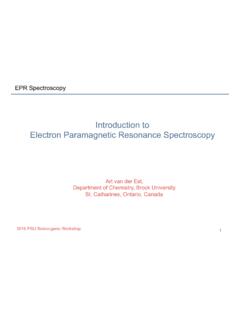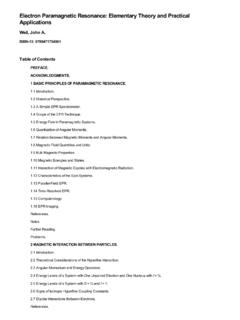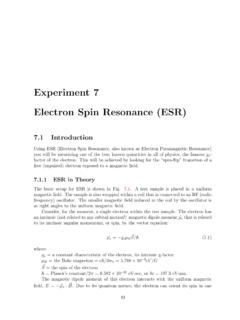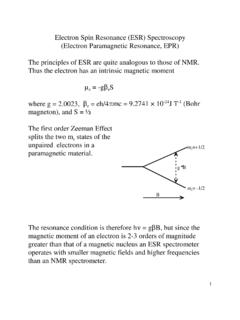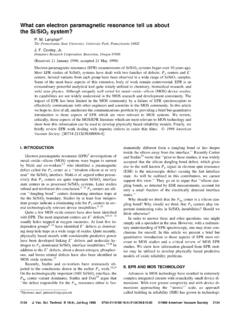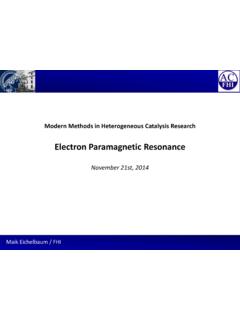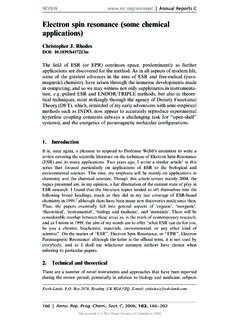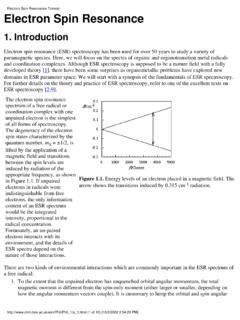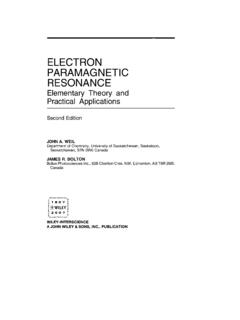Transcription of Multifrequency Electron Paramagnetic Resonance: Theory …
1 Wiley-VCH final 545 12 Distance Measurements: Continuous - Wave ( CW ) - and Pulsed Dipolar EPR Sushil K. Misra and Jack H. Freed Introduction Information on long - range distances between selected sites is a prerequisite to understanding the detailed structure of complex systems. In NMR utilizing a spin label, it is possible to measure distances in the range between 8 to, at most, 25 . On the other hand, with EPR, distances in the range between about 10 and 90 can and have been measured.
2 EPR spectroscopy may be the best practical technique for complex systems, since methods such as small - angle scat-tering, X - ray scattering and small - angle neutron scattering have insuffi cient con-trast whereas fl uorescence resonant energy transfer (FRET) lacks key virtues of EPR noted below. Distance measurements in EPR are based on exploitation of the dipolar interaction ( DI ), that depends on the distance between two paramag-netic probes, and which may be identical or may differ from each other, and are located at different spatial positions in the sample.
3 They can be introduced using site - directed mutagenesis (also known as site - directed spin labeling ; SDSL ), a technique which enables the investigation of, for example, proteins and other biomolecules. In fact, the signature of the DI can be clearly seen in CW - EPR spectra under favorable circ umstances for short distances. On the other hand, in pulsed EPR [hereafter referred to as pulsed dipolar spectroscopy ; PDS ), experi-ments can be designed specifi cally to clearly distinguish the dipolar interaction. The two commonly used PDS techniques are: (i) pulsed Electron double resonance ( PELDOR ; this term was originally coined by the Russians, who fi rst developed the technique), which is also referred to as double Electron - Electron resonance ( DEER ; this term was introduced later in the USA, and will be used hereafter in this chapter); and (ii) double quantum coherence ( DQC ) - EPR.]
4 DEER requires an experimental arrangement which is relatively simple to imple-ment and is currently available commercially. On the other hand, DQC requires instrumentation that can provide short, intense pulses and extensive phase - cycling . The quantitative results so obtained can be exploited to obtain distances, their distributions, and orientational correlations. Neither the DEER (PELDOR) nor DQC acronyms indicate that these techniques deal exclusively with dipolar Multifrequency Electron Paramagnetic resonance , First Edition. Edited by Sushil K.
5 Misra. 2011 Wiley-VCH Verlag GmbH & Co. KGaA. Published 2011 by Wiley-VCH Verlag GmbH & Co. final 546 12 Distance Measurements: Continuous-Wave (CW)- and Pulsed Dipolar EPRcouplings; hence the acronym PDS will be used collectively hereafter for these techniques. It is relevant at this point to compare distance measurements by PDS with those by the other commonly used techniques, specifi cally X - ray, NMR, and fl uorescence resonance energy transmission (FRET). It should fi rst be noted that PDS is often helped by and provides information supplementary to the structural informa-tion available from X - ray crytallography and NMR.
6 One of the greatest virtues of using EPR is that one only requires trace amounts (in the case of proteins or biomolecules, from nanomoles to picomoles; Klug et al. , 2005 ; Bhatnagar et al. , 2010; Georgieva, et al. , 2010) of the sample due to its EPR spin sensitivity. EPR is also amenable to study in diverse environments, such as dilute solutions, micelles, lipid vesicles, native membranes, supported lipid bilayers. Such measurements are frequently not possible with NMR or X - ray crystallography, where one requires, for example, larger quantities of samples, high - quality crystals (for x - rays), as well as high solubility (for NMR), and smaller molecules (NMR).
7 FRET is also used for distance measurements, as it is much more sensitive per fl uorophore than EPR, and can operate at biological temperatures. That is, FRET can be applied to fl uid solutions at room temperature, whereas the PDS - EPR experiments are conducted with frozen solutions. The main advantages of PDS over FRET are: The molecular size of the probes is smaller, so that the original structure is less distorted. In PDS, there is often used a methanethiosulfonate spin label ( MTSSL ), which introduces only a small perturbation to the structure and function of the protein.
8 Since the nitroxides, used in PDS, are smaller in size than most fl uorescent labels used in FRET, there is less uncertainty in their positions relative to the backbone of the protein. Attaching two similar Paramagnetic labels synthetically is less demanding than attaching two different donor and acceptor labels. The EPR technique can also be applied to opaque materials. The distances between the nitroxide spin - labels used in EPR is determined more accurately, as they are directly obtained from frequency measurements.
9 This contrast to the distances between chromophores used in FRET, where there exist uncertainties in the parameter 2 used for distance determination. Also, the distance distributions are readily obtained in PDS - EPR. This chapter is organized as follows. The Theory for distance measurements in EPR using the dipolar interaction is provided in Section , the CW - EPR methods used for distance determination are discussed in Section , and pulsed dipolar techniques in general are detailed in Section . The details of three - four - pulse DEER techniques, and their merits and disadvantages as compared to CW - EPR and FRET, are described in Section.
10 The density matrix calculations of echo signals for three - and four - pulse DEER sequences are given in detail in Appendices and , respectively. The DQC technique is described in Section , along with the density - matrix evolution algorithm used to calculate the DQC signal, while Wiley-VCH final The Dipolar Interaction and Distance Measurements 547sensitivity considerations and their Multifrequency aspects are discussed in Section . The subject of distance distributions, including Tikhonov regularization, is covered in Section , and the pertinent literature is reviewed in Section.



